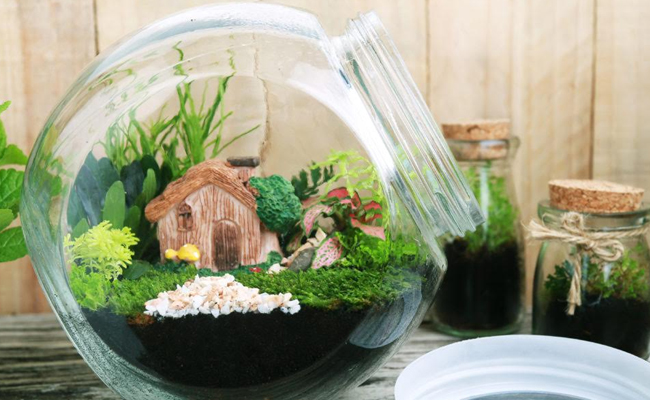Even if you think you’re not good with plants, a terrarium, which is sometimes called a “garden under glass,” makes a fantastic and impressive present. No matter how big or small a terrarium is, it will always include the same four components: gravel, moss, soil, and plants.
You don’t need a green thumb to keep a terrarium alive and well because they function like miniature ecosystems. Plants like tropical ferns, mosses, selaginella, peperomia, cryptanthus, and air plants do well in these environments because of the high humidity and low light levels.
Making your own little planet is easier than you think; all you need are some stones, some horticultural charcoal, and some potting soil layered in a glass jar. Now let’s find out how to make a terrarium.

Contents
What Is a Terrarium?
A terrarium is a miniature greenhouse that may be kept indoors. Typically, it is made of encased or partially encased glass, which lets in heat and light while keeping moisture out. The Latin roots of the word “terrarium” are the noun “terra” (earth) and the verb “arium” (place or receptacle).
A terrarium can be used for a wide variety of applications. Whether for aesthetic purposes, academic research, or plant propagation, they can be made. Many different types of glass containers make beautiful vessels for DIY terrariums, and all it takes is an hour or two to set up a basic terrarium.
Miniature terrarium plants are adorable, and they’re usually only a few dollars a pop. Read on for advice on where to get a terrarium, what plants to put in it, and how to keep them alive and thriving.
Before Getting Started
greater terrariums can accommodate houseplants of a little greater size; however, rapid growers and those with particularly huge leaves should be avoided. Choose terrarium plants that can survive with minimal to moderate illumination.
Select a variety of leaf sizes, textures, and colors to create visual interest. Choose plants that will flourish in the terrarium’s high humidity. Plants like cacti and succulents do better in open containers with lots of gritty sand in the potting mix, so don’t put them in a terrarium.
Choose Your Container
Select a suitable storage vessel first. In order to provide the plants with the condensation they need to flourish, we chose food canisters because they are cheap and easy to find. It’s important to remember, though, that not every container can be turned into a terrarium.
If you want your plants to thrive, you need keep them in a humid environment. Find interesting containers like clear soup tureens, kitchen jars, and empty bottles by digging through your basement, attic, and cupboards.
How to Make a Terrarium
The next step in creating your terrarium is choosing the right container for it. Avoid clumsily inserting the structure when laying the pebble drainage base. Add fine dirt or pebbles to your terrarium with the help of a pastry bag without a tip for even distribution and precision.
Step 1: Put down a 1-inch layer of pebbles or gravel as a drainage basis.
Step 2: Sprinkle a little bit of gardening charcoal on top.
Step 3: Put in some potting dirt.
Step 4: Make sure none of the plants’ leaves, petals, or stems are touching the glass by nestling them securely into the dirt and covering the roots.
Step 5: You can embellish it with figurines and oddly shaped rocks if you wish.
How to Care for Your Terrarium
While terrariums are simple to construct, they do require some maintenance to ensure the health of the plants within. Display the mini ecosystems throughout your home with care, and make sure they get enough water and light.
Water
Overwatering your plants is the worst thing you can do for them, so be cautious while watering them. Simply spritz twice with water and close the lid, taking care that no water collects in the jar’s base.
Condensation forms on the inside of terrariums because they function like miniature greenhouses. Reduce the terrarium’s lighting or leave the lid off for two hours if you notice moisture forming.
Light
Most terrariums thrive under a south-facing window or another location that provides indirect sunlight. Never put your terrarium where the afternoon sun will beat down on the foliage like a windowsill.
Humidity
Terrariums need a lot of moisture. Humidity is trapped and your plants thrive when the terrarium is closed. So, if you need to use a container but don’t have a lid, you’ll need to get creative: Carr advises placing a glass plate on top of a terrarium in the absence of a lid.
Alternative: “Or if it’s a narrow-necked bottle, use a lightbulb to block the opening and create extra humidity.”
Conclusion
You don’t need a green thumb to keep a terrarium alive and well because they function like miniature ecosystems. Plants like tropical ferns, mosses, selaginella, peperomia, Cryptanthus, and air plants do well in these environments because of the high humidity and low light levels.
Making your own little planet is easier than you think; all you need are some stones, some horticultural charcoal, and some potting soil layered in a glass jar. Click here to find out how to make a terrarium.






























